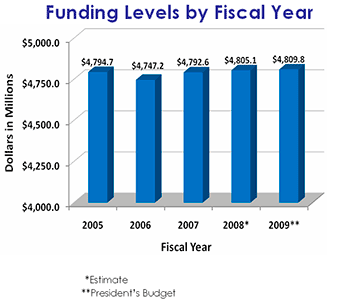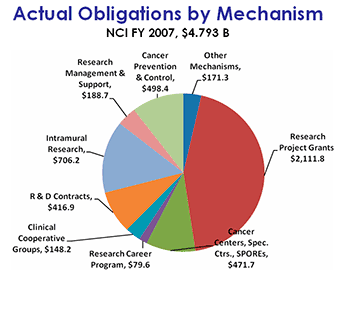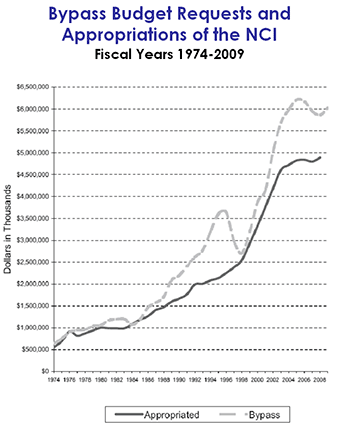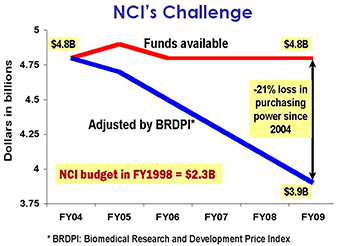|
NCI Budget Snapshot NCI Budget Overview
Economic Value
NCI Budget Challenges
Funds available to the NCI in FY 2007 totaled over $4.792 billion, reflecting an increase of 1% and $45 million from the previous fiscal year.

Fiscal highlights from FY 2007 include:
- Of the total NCI budget, 44% of the funds were allocated for Research Project Grants (RPGs).
- The total number of RPGs funded was 5,472.
- Almost one-fourth of the RPGs awarded were new (Type 1) or competing renewal (Type 2) awards.
- 1,312 competing RPGs were funded.
- Approximately one-third of the total NCI budget supported ongoing non-competing (Type 5) RPGs.
- R01 grants were funded to the 15th percentile.

- 278 grants - totaling $94 million - were funded as Small Business Innovation Research (SBIR) and Small Business Technology Transfer (STTR) awards.
- Intramural Research comprised 15% of the total NCI budget in FY 2007.
- $498 million - 10% of the total NCI budget - was allocated for Cancer Prevention & Control.
The economic value that individuals place on the current and future benefits that flow from a 1% decline in cancer mortality has been estimated to be nearly $500B1. Based on this estimate, the estimated 2% decline in cancer mortality for 2004 alone is worth about $1 trillion. NCI's cumulative budget, in 2004 dollars, from 1950-2004 is about $116 billion. Therefore, the value of one year's reduction in cancer mortality is nearly 10 times the entire NCI budget for the past 55 years.

The below-inflation budgets of the last few fiscal years (2005-2007) have impacted both NCI's internal and external capabilities. Indeed, implications of the budgetary constraints have carried beyond the basic research laboratories, impacting the clinical research options available to patients. For example, the NCI's Clinical Trial Cooperative Groups, which promote and support clinical trials of new cancer treatments, explore methods of cancer prevention and early detection, and study quality-of-life issues and rehabilitation during and after treatment, experienced a funding reduction of 10.9 percent between FY 2002 and 2006. Although some of the lost funding was restored in FY 2007, fewer trials have been started, and fewer patients have been enrolled in available trials. This slows NCI's ability to improve the standard of care for cancer patients through new drugs, devices, or interventions.
Between the fiscal years 2004 and 2009, NCI's budget will remain relatively flat. However, factoring in the rate of biomedical inflation reveals a 21 percent loss of purchasing power over those same years. Scientific investigators indicate that below inflation funding often means the loss of a laboratory technician or two, a graduate student not brought into the lab, a postdoctoral fellow not hired or research that must be scaled back to the point that scientific progress is significantly slowed and some opportunities are lost. The problem is compounded because these investigators - some of whom are turning away from biomedical science - are also the professors who nurture the careers of young scientists who will drive the future of cancer medicine.

1. Murphy KM, Topel RH. The Value of Health and Longevity. Journal of Political Economy. Volume 114, Issue 5, Page 871-904, Oct 2006.
Back to Top |